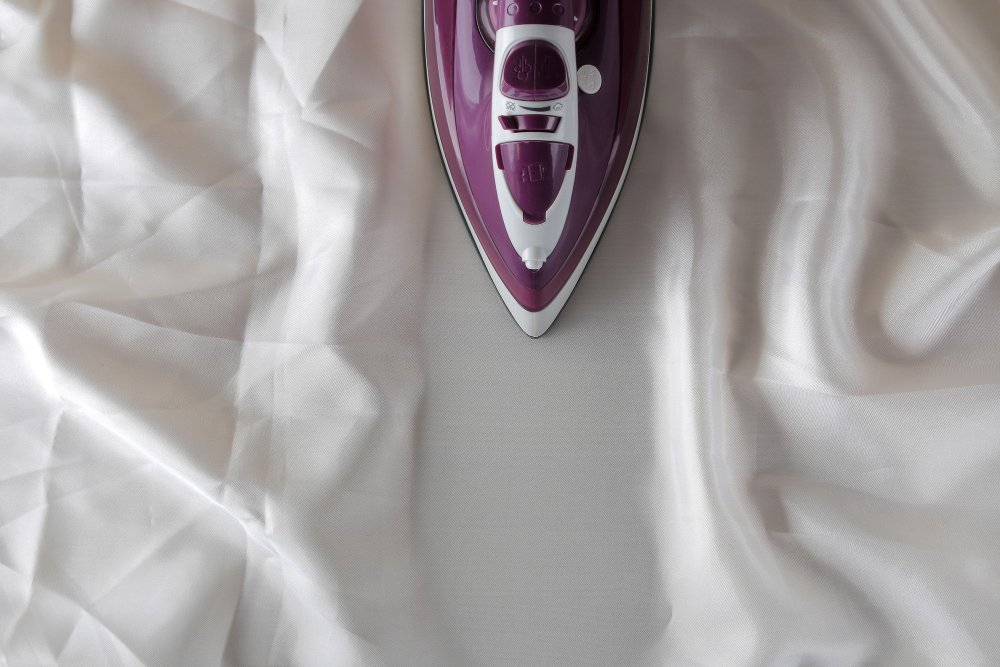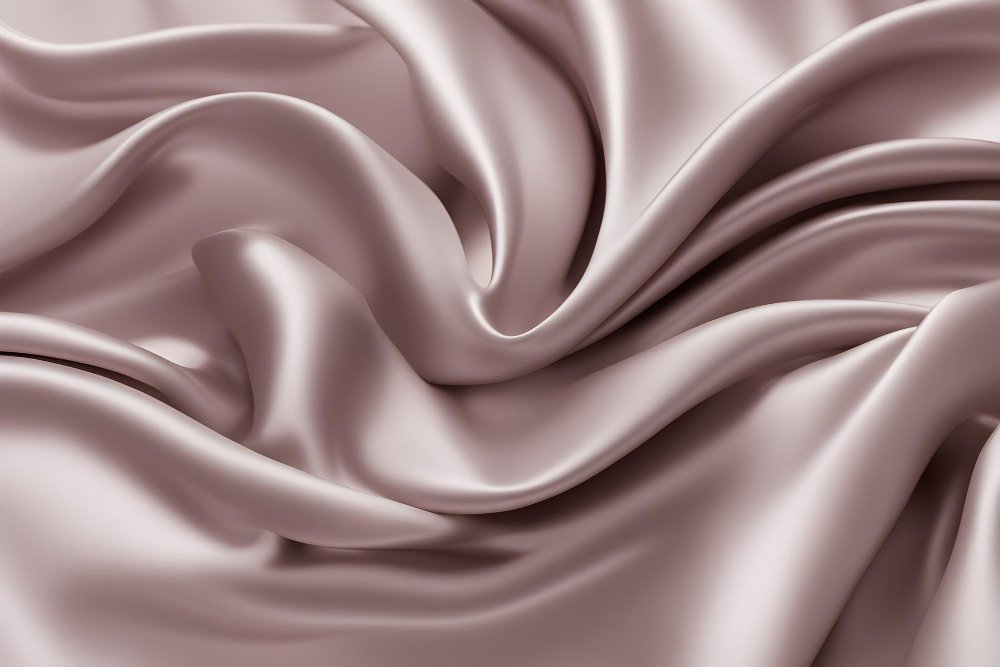Everything you need to know about raw silk, from its unique properties to care instructions and sustainable fashion choices
Table of Contents
- What is Raw Silk?
- Types of Raw Silk
- Characteristics and Properties
- Raw Silk vs Other Fabrics
- Sustainability and Ethics
- Uses and Applications
- Care Instructions
- Buying Guide
- Sewing with Raw Silk
- History and Cultural Significance
- Price and Value
- Health and Skin Benefits
- Current Market Trends
- Frequently Asked Questions
What is Raw Silk?
Raw silk is a type of silk fabric that keeps much of its natural character. Unlike the smooth, glossy silk you might see in evening gowns, raw silk has a slightly rough, nubby texture that gives it an earthy, organic look. Think of it as the difference between polished marble and natural stone.
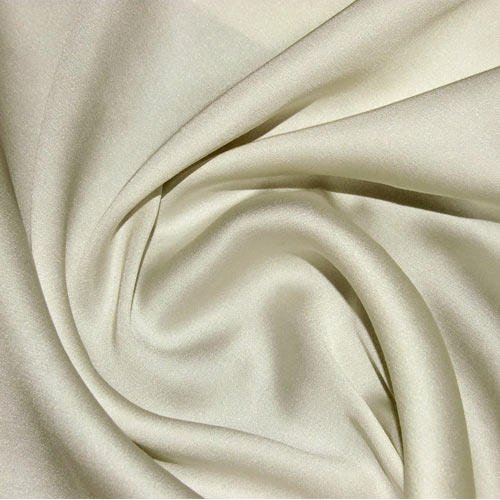
Is raw silk real silk? Yes, absolutely. Raw silk is 100% real silk that comes from silkworm cocoons. The key difference is that it goes through less processing than traditional silk. The natural protein called sericin, which acts like a gum holding the silk fibers together, stays on the fabric longer or isn’t completely removed.
Here’s where it gets a bit tricky: the term “raw silk” can mean different things. Sometimes it refers to silk yarns before any finishing work happens. Other times, people use it to describe silk noil, which is made from the short fibers left over after spinning silk. These leftover bits would normally be thrown away, but instead they’re collected and woven into fabric. This makes silk noil a great example of reducing waste in the textile industry.
Key Point: Raw silk and silk noil are often used to describe the same fabric, even though they’re technically different. Most fabric you’ll find labeled as “raw silk” is actually silk noil that’s been dyed and pressed.
How is Raw Silk Made?
The production of raw silk starts the same way as regular mulberry silk. Silkworms spin cocoons from a single, continuous thread that can stretch up to a mile long. For traditional silk, these cocoons are boiled with the worm still inside, then the long fibers are reeled off.
For raw silk and silk noil, the process is different:
- Short fibers from broken or damaged cocoons are collected
- Fibers left over after the main reeling process are saved
- These shorter fibers go through some processing like degumming (removing sericin)
- The fibers are then spun into yarn
- Finally, the yarn is woven into fabric
Because the fibers are shorter and the sericin isn’t completely removed until later in the process, the final fabric has that signature textured, slightly stiff feel.
Where Did Raw Silk Come From?
The story of silk goes back thousands of years to ancient China, around 2700 BCE. Legend says that Empress Lei Zu discovered silk when a cocoon fell into her tea. As she tried to fish it out, it began to unravel, revealing a beautiful, shimmering thread.
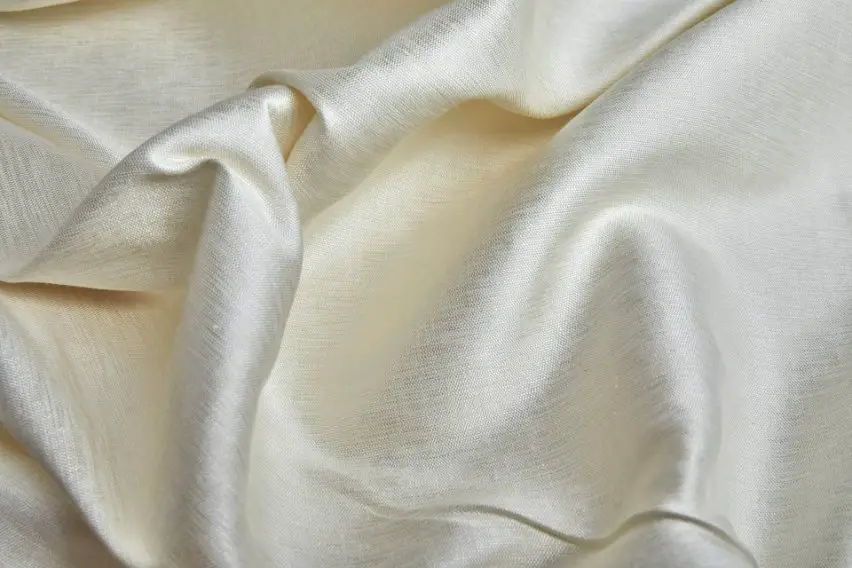
While that’s a charming story, archaeological finds show that silk production in China dates back even earlier, to around 3000 BCE in the Yellow River valley. For over 2,500 years, China kept silk production a closely guarded secret. Eventually, the knowledge spread along the Silk Road to other parts of Asia and beyond.
Today, China remains the world’s largest producer of raw silk, followed by India. Together, these two countries produce over 90% of the world’s silk, according to the Food and Agriculture Organization (FAO). In India, states like Karnataka, West Bengal, and Assam are particularly well-known for silk production.
Types of Raw Silk
Not all raw silk is created equal. There are several types, each with unique characteristics based on what the silkworms eat and where they’re raised.
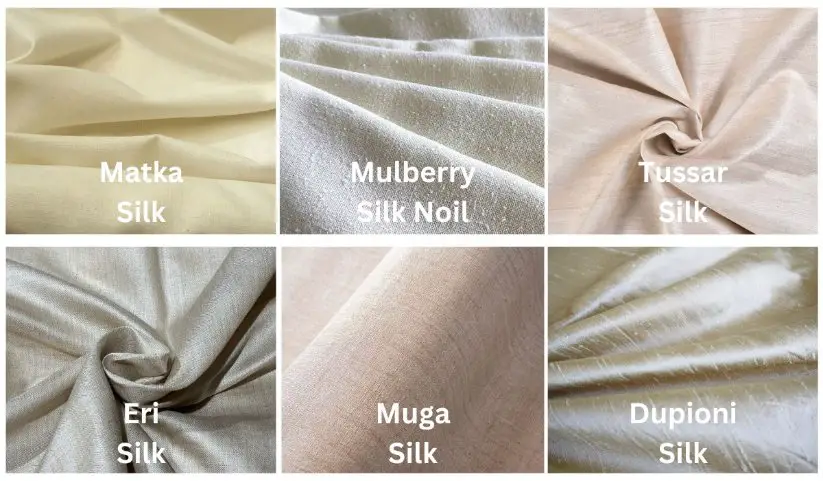
Mulberry Silk Noil
This is the most common and finest type of raw silk. It comes from silkworms that eat only mulberry leaves. The short fibers from damaged cocoons create a soft, relatively smooth fabric with a subtle sheen. It’s what most people mean when they say “raw silk.”
Tussar (Tussah) Silk
Wild silkworms that feed on oak and juniper trees produce Tussar silk. These worms live in forests rather than farms, and their cocoons are usually collected after the moths have already emerged. This makes Tussar silk more sustainable than regular silk.
Tussar has a natural golden-brown color that comes from the tannin in the trees the worms eat. The texture is coarser than mulberry silk, with a beautiful irregular surface that looks almost like linen fabric. It’s less expensive than mulberry silk and perfect for warm-weather clothing.
Eri Silk
Often called “peace silk” or “ahimsa silk,” Eri silk comes from silkworms that feed on castor plant leaves. The big difference? The moths are allowed to emerge from their cocoons naturally before the fiber is harvested, so no silkworms die in the process.
Eri silk has a coarse yet fine texture. It’s mainly produced in Assam, India, and parts of China and Japan. Because it’s considered more ethical, Eri silk has grown in popularity among eco-conscious fashion lovers.
Muga Silk
Muga silk is exclusive to Assam, India. The silkworms feed on aromatic Som and Sualu leaves, which give the silk a natural golden color. Muga is known for being incredibly strong and durable, with a smooth, glossy texture. It’s also one of the most expensive types of silk because it can only be produced in one region.
Matka Silk
Matka silk is a specific type of silk noil made from the Bombyx Mori silkworm (the same one that makes mulberry silk). The name comes from “matka,” the clay pot where the short fibers are stored before spinning.
This silk has a thick, nubby texture and beautiful drape. It’s often compared to linen and is a favorite for high-end fashion. Think of the elegant silk suits worn on runways.
Dupioni Silk
Dupioni silk is woven from double cocoons, where two silkworms have spun their cocoons together. This creates irregular, slubbed yarns that give the fabric its characteristic uneven texture. Dupioni is particularly popular for wedding dresses and formal wear because of its crisp feel and lustrous appearance.
Characteristics and Properties of Raw Silk
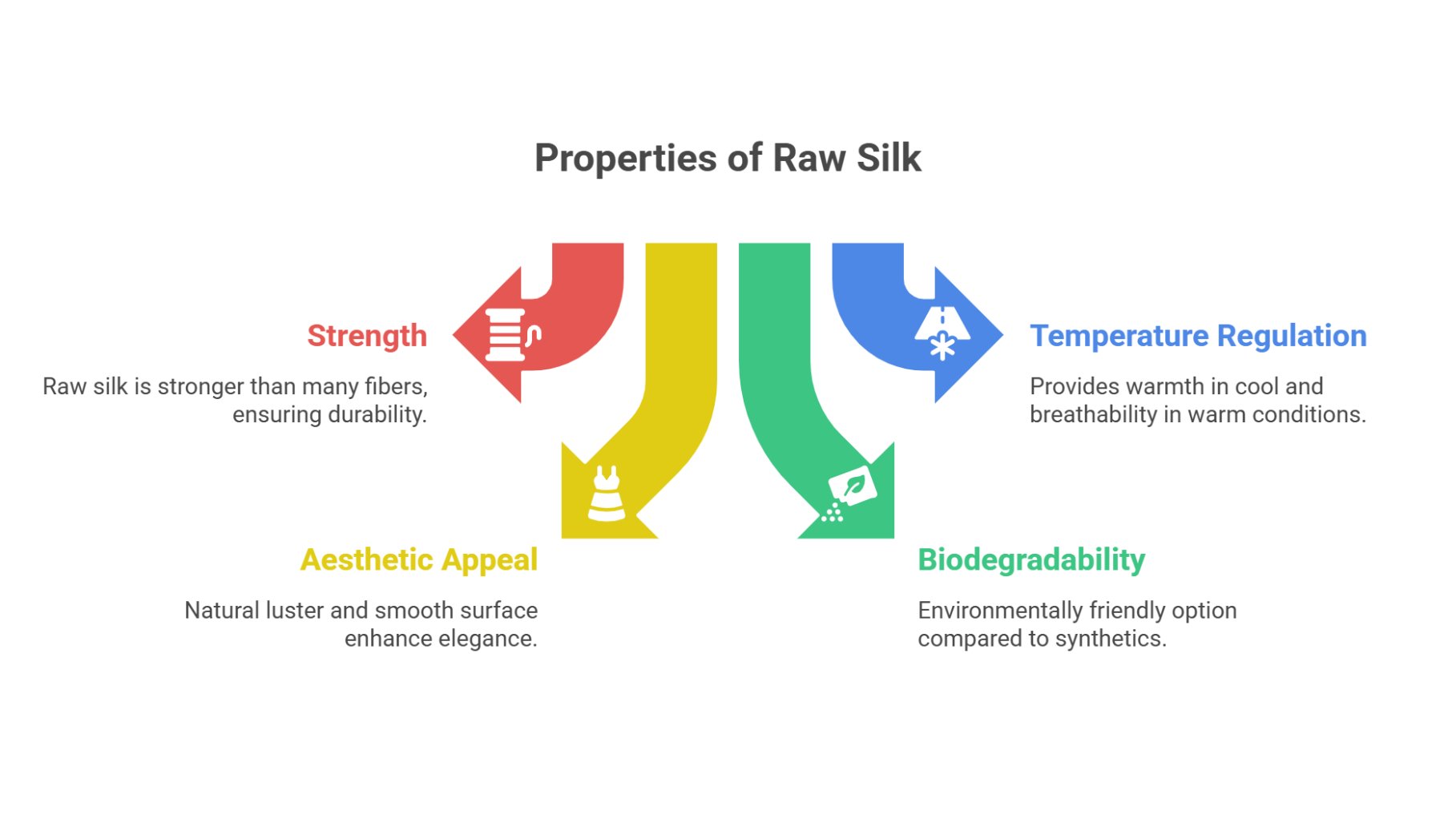
What Does Raw Silk Look Like?
Raw silk has a distinctive appearance that sets it apart from regular silk:
- Texture: Nubby, slightly irregular surface with visible slubs (thick spots in the yarn)
- Sheen: Matte to subtle shine, not the high gloss of satin or charmeuse
- Color: Natural creamy off-white to pale gold, but dyes beautifully
- Weave: Often has a plain, linen-like weave pattern
What Does Raw Silk Feel Like?
Is raw silk stiff? When you first buy raw silk, it often feels crisp and slightly stiff. This comes from the natural oils and remaining sericin. However, this stiffness softens beautifully after washing. Many sewers actually prefer to pre-wash raw silk several times to get that soft, lived-in feel.
The texture feels somewhere between traditional silk and cotton fabric. It’s not slippery like satin, which actually makes it easier to work with. The fabric has a pleasant, slightly rough hand that many people find more comfortable than super-smooth silk.
Physical Properties
Raw silk combines several practical qualities:
Want to compare different fabric types? Try our Interactive Fabric Comparison Tool to see how raw silk stacks up against other natural fibers.
- Breathability: Air flows through the fabric well, helping regulate body temperature
- Moisture-wicking: Pulls moisture away from skin, keeping you comfortable
- Temperature regulation: Keeps you cool in summer and warm in winter
- Durability: Stronger than many refined silks because of retained sericin
- Drape: Has good drape without being too clingy
- Weight: Available in various weights, from shirt weight to suiting
Does Raw Silk Stick to the Body?
No, raw silk doesn’t cling to your body like some synthetic fabrics do. Thanks to its breathability and slightly textured surface, it drapes nicely without sticking. However, silk noil specifically can be a bit clingy compared to linen or cotton of similar weight, so fitted or structured garments work better than super loose, drapey styles.
Does Raw Silk Smell?
Fresh raw silk might have a slight natural smell from the sericin protein, but it’s not unpleasant. Some people describe it as earthy or slightly musky. This smell goes away completely after the first wash. If you notice a strong chemical smell, it likely comes from dyes or finishes applied during manufacturing.
Raw Silk vs Other Fabrics
Raw Silk vs Pure Silk
Which is better: raw silk or pure silk? It depends on what you need. “Pure silk” usually refers to fully processed silk like charmeuse or satin that’s been degummed, dyed, and finished to create a smooth, lustrous fabric.
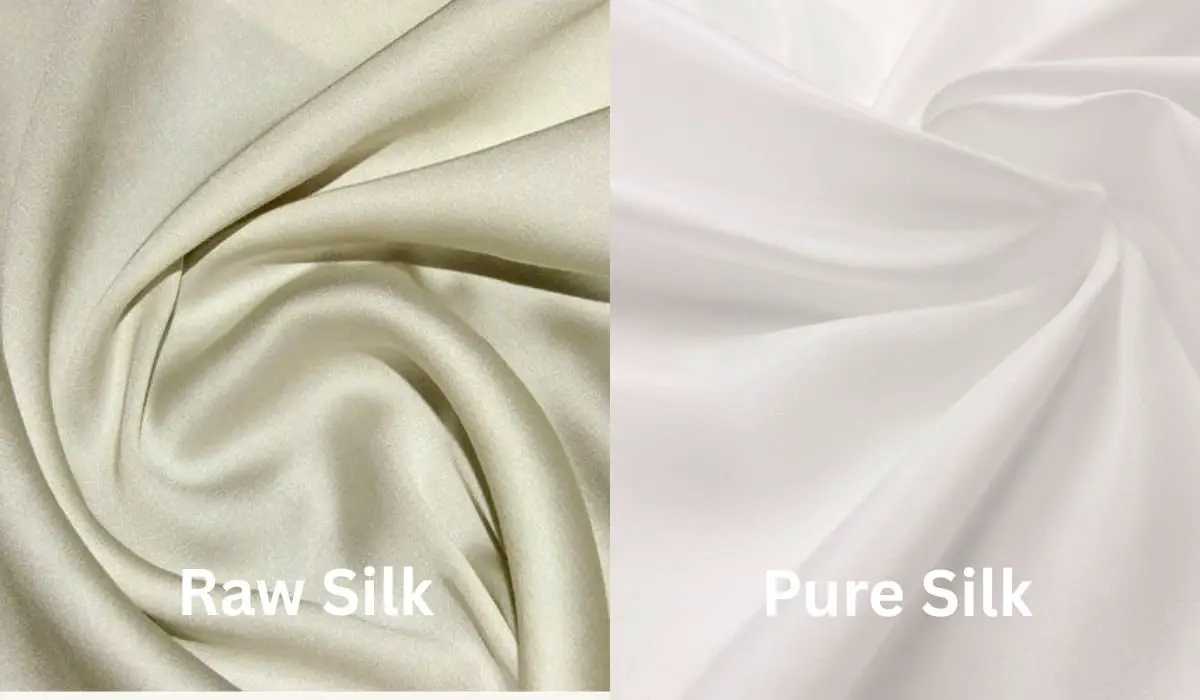
| Feature | Raw Silk | Pure Silk |
|---|---|---|
| Texture | Nubby, slightly rough | Smooth, slippery |
| Sheen | Matte to subtle | High gloss, lustrous |
| Drape | Structured, some body | Fluid, flowing |
| Care | Can be machine washed (with care) | Usually requires hand washing or dry cleaning |
| Price | $20-30 per yard | $30-80 per yard |
| Best for | Casual wear, suits, structured garments | Evening wear, lingerie, delicate items |
| Sewing difficulty | Easier (less slippery) | More challenging |
Raw Silk vs Art Silk
Art silk (artificial silk) is a synthetic fabric made from rayon, polyester, or other man-made fibers. While it can look similar to raw silk at first glance, there are clear differences:
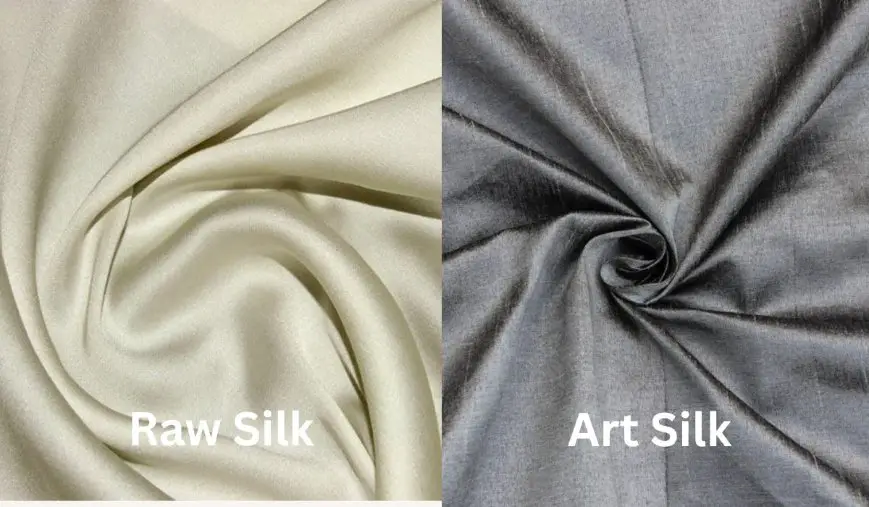
| Feature | Raw Silk | Art Silk |
|---|---|---|
| Origin | Natural (silkworms) | Synthetic (chemicals) |
| Shine | Duller, uneven | Uniform, bright |
| Feel | Slightly coarse, natural | Soft, slippery, sometimes plasticky |
| Breathability | Excellent | Poor |
| Temperature | Adapts (cool/warm) | Doesn’t regulate |
| Durability | Lasts years with care | Tends to fade, tear faster |
| Price | Higher | Much cheaper |
| Sustainability | Biodegradable | Not biodegradable |
How to tell if something is raw silk:
- Touch test: Real silk feels cool and slightly coarse; art silk feels plastic-like
- Shine test: Raw silk has duller, uneven shine; art silk glows uniformly
- Price check: If it’s very cheap, it’s probably not real silk
- Burn test: Real silk burns slowly with a smell like burning hair; synthetic melts and smells like plastic
Cotton Silk vs Raw Silk
Cotton silk is a blend of cotton and silk fibers. Which is better? Raw silk wins for luxury feel, drape, and temperature regulation. Cotton silk blends are more affordable and easier to care for, but they lose some of silk’s special properties.
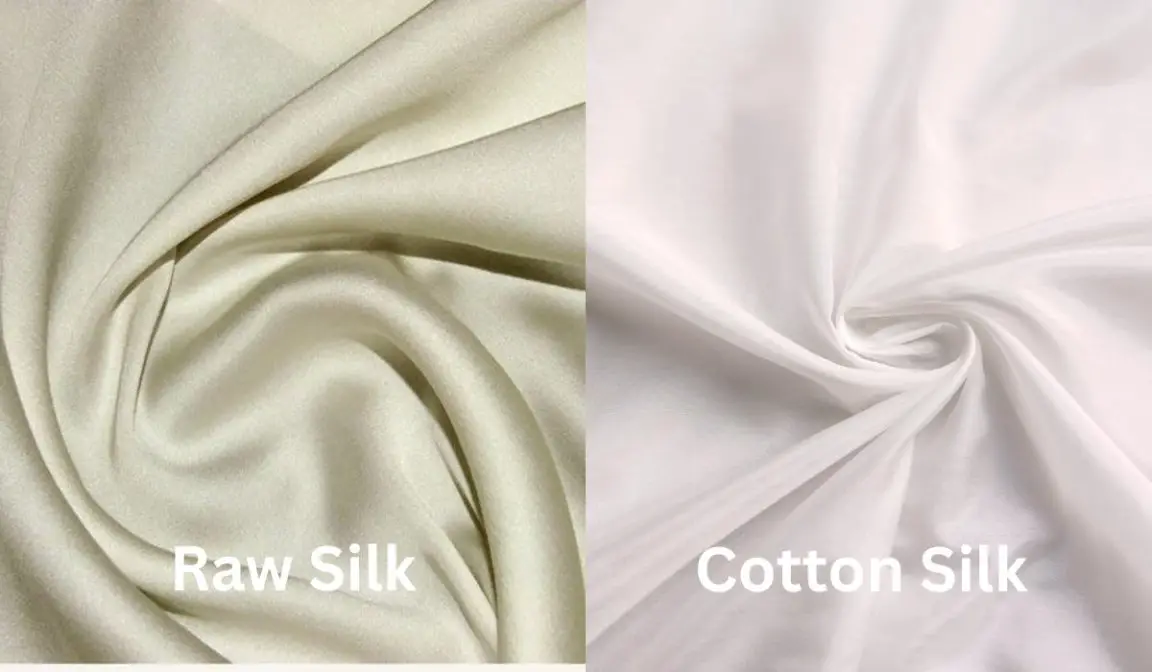
What is the Difference Between Chanderi Silk and Raw Silk?
Chanderi silk is a specific fabric from the Chanderi region in India. It’s made from a blend of silk and cotton, creating a lightweight, sheer fabric with a glossy texture. Raw silk, on the other hand, is 100% silk with a matte, textured finish. Chanderi is better for flowing, delicate garments, while raw silk works for structured, everyday pieces.

Sustainability and Ethics
Is Raw Silk Ethical?
This is a complicated question. Traditional silk production involves boiling silkworms alive in their cocoons. About 6,600 silkworms die to make just one kilogram of silk. This raises serious ethical concerns for many people.
Raw silk can be more ethical, depending on the type:
- Wild/Tussar silk: Cocoons are collected from forests after moths emerge naturally
- Peace/Ahimsa silk: Moths are allowed to break out of cocoons before harvesting
- Conventional raw silk: May still involve killing silkworms
Important note about peace silk: While peace silk sounds perfect, it has limitations. After thousands of years of breeding, domesticated silkworms can’t survive well outside their cocoons. They can’t see or fly properly and usually die quickly even when “freed.” Also, there’s no certification system for peace silk, so regular silk is sometimes sold as peace silk.
Environmental Impact
The sustainability of raw silk has both pros and cons:
Positives:
- Biodegradable and decomposes naturally
- Renewable resource from silkworms
- Less water-intensive than cotton for finished product
- Can last for years, reducing need for replacement
- Silk noil uses waste fibers that would be discarded
Negatives:
- Energy-intensive production (climate control for worms, drying cocoons)
- Scores high on the Higg Materials Sustainability Index for environmental impact
- Uses more water and creates more emissions than cotton overall
- Sericin disposal can pollute water if not handled properly
- Growing mulberry leaves requires significant land
According to the Higg Materials Sustainability Index, silk ranks among the highest-impact materials due to energy use, water consumption, and greenhouse gas emissions.
Making Better Choices
If you want more sustainable silk:
- Look for GOTS (Global Organic Textile Standard) certified silk
- Choose Oeko-Tex certified fabrics (free from harmful chemicals)
- Buy from brands that are transparent about their supply chain
- Consider recycled or reclaimed silk from vintage garments
- Opt for wild silk when possible
- Buy less, choose quality, and care for it well
Social and Labor Concerns
The four largest silk-producing countries (China, India, Uzbekistan, and Brazil) all have documented issues with forced labor and child labor in their silk industries. In Uzbekistan, children as young as 5 have been reported working from 4 AM to midnight picking mulberry leaves.
Without clear information from brands about their suppliers, it’s hard to know if the silk you’re buying was made ethically. Look for brands that provide full supply chain transparency.
Uses and Applications
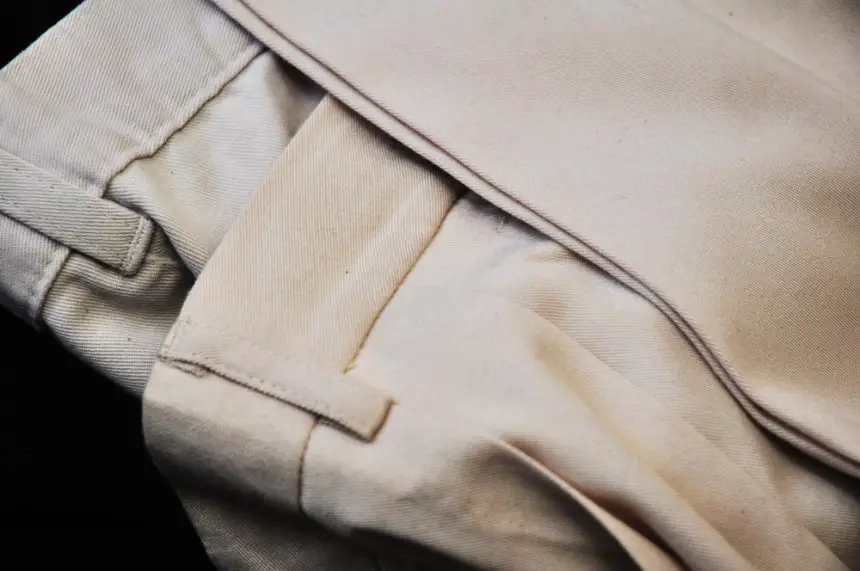
Is Raw Silk Good to Wear?
Absolutely! Raw silk makes excellent clothing for several reasons:
- Comfortable against skin without being too clingy
- Breathes well, perfect for all seasons
- Looks polished but not overly formal
- Works for both casual and dressy occasions
- Wrinkle-resistant compared to other silks
- Flattering drape that doesn’t cling to every curve
Fashion and Clothing
Raw silk shines in structured garments:
- Suits and blazers: The fabric holds shape beautifully (think Givenchy suits)
- Dresses and skirts: Especially shift dresses and A-line styles
- Blouses and shirts: Professional yet comfortable
- Wedding wear: Dupioni silk is hugely popular for wedding dresses
- Pants and trousers: Structured styles work best
- Accessories: Scarves, ties, and bags
Is Raw Silk for Winter?
Raw silk works year-round thanks to its temperature-regulating properties. In winter, it provides warmth without bulk. In summer, it keeps you cool. The slightly thicker texture of raw silk makes it particularly nice for cooler weather, especially in jacket and blazer weights.
Home Décor
Raw silk adds texture and sophistication to home furnishings:
- Curtains and drapes
- Upholstery for chairs and sofas
- Cushion covers and throw pillows
- Bedding (though it requires more care than mulberry silk)
- Table runners and placemats
Cultural and Traditional Garments
Raw silk plays an important role in traditional clothing around the world:
- Indian saris: Tussar and Matka silk are favorites for traditional and contemporary saris
- Japanese kimonos: Various raw silks add texture to formal wear
- Chinese formal wear: Used in traditional garments and modern fashion
- Western bridal fashion: Dupioni silk wedding dresses remain timeless
Care Instructions
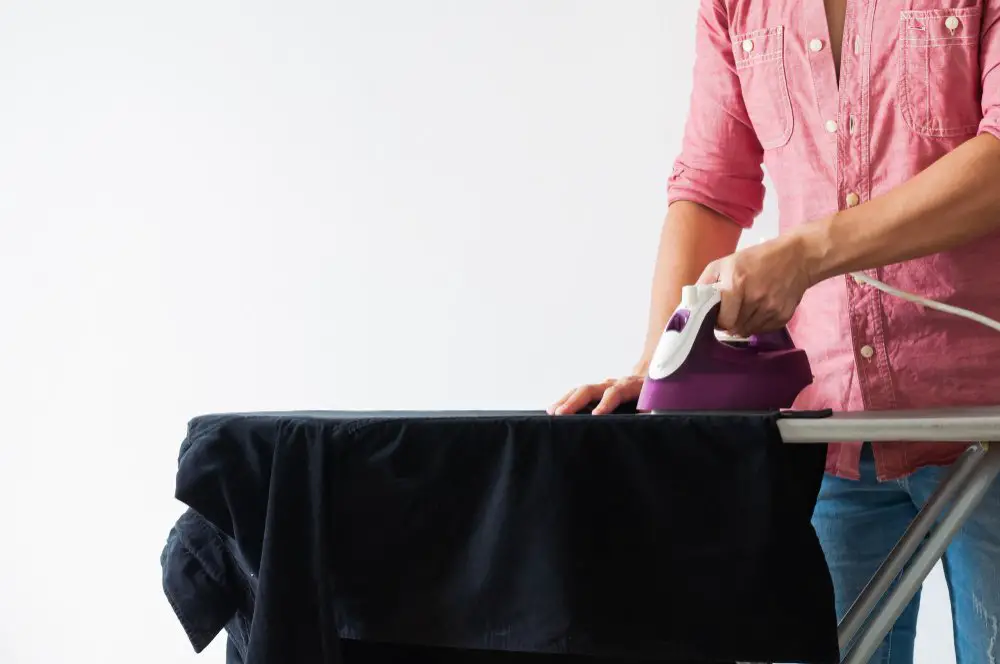
Is Raw Silk Washable?
Yes! One of the best things about raw silk (especially silk noil) is that it’s the most washable type of silk. You can machine wash it, though hand washing is gentler. This makes raw silk much more practical for everyday wear than delicate silk charmeuse.
How to Wash Raw Silk
Method 1: Machine Washing
- Use cold or lukewarm water (never hot)
- Choose gentle or delicate cycle
- Use pH-neutral detergent or mild baby shampoo
- Don’t use bleach or harsh chemicals
- Wash with similar colors (dark colors may bleed first wash)
Method 2: Hand Washing (Recommended)
- Fill basin with cold water
- Add small amount of gentle detergent
- Gently swish fabric (don’t wring or twist)
- Rinse in cold water until detergent is gone
- Press out water gently (don’t wring)
First wash tip: Expect 2-5% shrinkage the first time you wash raw silk. Always pre-wash fabric before sewing, and wash finished garments the same way you’ll care for them long-term.
Drying Raw Silk
- Best method: Lay flat to dry away from direct sunlight
- Alternative: Hang to dry (may create some wrinkles)
- Tumble dry: Only if pre-washed this way; use low heat
- Avoid: High heat and direct sunlight (can fade colors)
Ironing and Pressing
Raw silk wrinkles less than other silks, but you may still want to press it:
- Iron while slightly damp for best results
- Use medium heat setting (silk setting if available)
- Always use a press cloth or iron inside-out
- Avoid steam on dark colors (can cause water spots)
- Press gently; don’t scrub the iron back and forth
Storage
- Store in cool, dry place
- Avoid plastic bags (silk needs to breathe)
- Use cotton garment bags for long-term storage
- Keep away from direct sunlight
- Don’t store in damp areas (prevents mildew)
Stain Removal
Act quickly when stains happen:
- Blot (don’t rub) fresh stains immediately
- For washable stains, use cold water and gentle soap
- Test any cleaning solution on hidden area first
- For oil-based stains, consider professional dry cleaning
- Never use harsh chemicals or bleach
For more detailed silk care instructions, check out our complete guide. You can also use our Silk Care Calculator to get personalized care instructions based on your specific silk type.
Softening Stiff Raw Silk
New raw silk can feel quite stiff. To soften it:
- Wash several times in warm water with gentle detergent
- The natural oils will wash out, fibers will open up
- Fabric becomes softer and more drapey with each wash
- Don’t fight the texture – it’s part of raw silk’s charm!
Buying Guide
How to Identify Raw Silk Fabric
When shopping for raw silk, look for these quality indicators:
Visual inspection:
- Uneven texture with visible slubs
- Matte or subtle sheen (not high gloss)
- Slightly irregular weave pattern
- Natural color variations in undyed fabric
Touch test:
- Feels cool against skin initially
- Slightly crisp or stiff when new
- Not slippery like satin
- Has some body and structure
Weave check:
- Look for plain weave pattern similar to linen
- Small, uneven bumps in the yarn (slubs)
- Slightly loose weave visible when held to light
Quality Grades
Raw silk comes in different quality grades:
- Grade A (6A-A): Highest quality, long fibers, minimal defects, pearly white color
- Grade B: Shorter fibers, some clumps, uneven texture
- Grade C: Used for filling (pillows, duvets)
- Lower grades (D-F): Poor quality, used for rugs and drapes
For clothing and quality home goods, stick with Grade A or B.
Price Guide
Why is raw silk so expensive? Even though it uses leftover fibers, raw silk still requires significant labor and resources. However, it’s generally more affordable than premium silk varieties.
| Silk Type | Price per Yard | Value |
|---|---|---|
| Silk Noil/Raw Silk | $20-30 | Best for everyday luxury |
| Charmeuse/China Silk | $30-80 | Delicate, special occasions |
| Dupioni Silk | $25-40 | Wedding wear, formal events |
| Tussar Silk | $18-28 | Eco-friendly, casual wear |
| Muga Silk | $50-100+ | Luxury, very durable |
Where to Buy
Look for raw silk at:
- Specialty fabric stores
- Online fabric retailers (Mood Fabrics, Fabric.com)
- Indian or Asian fabric suppliers
- High-end department stores (for ready-made garments)
- Sustainable fashion brands (for ethical options)
What to Avoid
Watch out for these red flags:
- Labels saying “silk-like” or “satin” (probably synthetic)
- Extremely cheap prices (too good to be true)
- Perfect, uniform texture (likely polyester)
- Strong chemical smell
- Sellers who won’t provide fiber content information
Sewing with Raw Silk
Is Raw Silk Easy to Sew?
Yes! Raw silk is one of the easiest silks to sew with. Unlike slippery charmeuse or delicate chiffon, raw silk behaves more like cotton or linen. This makes it perfect for beginners who want to work with silk.
Comprehensive guide to sewing with silk, covering fabric selection, pre-washing, cutting, and finishing techniques
Is Raw Silk Hard to Sew?
Not at all. The main challenges are minor:
- Fraying: The loose weave means edges can fray
- Shrinkage: Must pre-wash before cutting
- Stiffness: New fabric can be harder to pin
- Clinging: Silk noil can cling to some body types
These are all easy to work around with proper technique.
Tips for Sewing Raw Silk
Before You Start:
- Pre-wash fabric 2-3 times to remove shrinkage and soften
- Press fabric before cutting
- Use sharp fabric scissors or rotary cutter
- Cut quickly and precisely to minimize handling
Sewing Essentials:
- Needle: Size 11/75 universal or microtex needle
- Thread: Poly-cotton thread or 100% cotton
- Stitch length: 2.5mm works well
- Interfacing: Use lightweight fusible or silk organza for structure
Finishing Seams:
- Use French seams for clean finish
- Serge edges to prevent fraying
- Or use bound seams
- Fully line garments when possible
For more sewing tips, visit our beginner’s guide to sewing. Not sure if raw silk is right for your project? Use our Fabric Type Selector Tool to get personalized recommendations.
Best Patterns for Raw Silk
Raw silk works beautifully in:
- Structured blazers and jackets
- Shift dresses and A-line skirts
- Button-up shirts and blouses
- Wide-leg or straight-leg pants
- Simple camis and tops
Avoid super drapey or gathered styles unless you want the fabric to cling.
Common Sewing Problems and Solutions
Problem: Fabric ravels at seam line
Solution: Finish seams immediately after stitching; use French seams or serging
Problem: Colors bleeding when wet
Solution: Set colors by ironing while damp; wash dark colors separately first time
Problem: Fabric too stiff to work with
Solution: Pre-wash multiple times in warm water; fabric will soften
Problem: Needle leaves holes
Solution: Use sharp, fine needle; don’t re-stitch same holes
History and Cultural Significance
Silk has played a major role in human civilization for thousands of years. The Chinese discovery of silk around 2700 BCE led to the development of the Silk Road, a network of trade routes connecting East and West.
For centuries, silk was worth its weight in gold. It symbolized wealth, power, and status. Only royalty and nobility could afford it. The Chinese guarded the secret of silk production so carefully that revealing it was punishable by death.
Eventually, silk production spread to Japan, India, and beyond. Each culture developed its own silk traditions:
India: Silk became essential to religious ceremonies and weddings. Different regions developed unique silk types like Tussar, Muga, and Eri. India now produces 23% of its total cloth through handloom, employing 6.5 million people.
Japan: Silk became the foundation of the kimono industry. Japanese artisans developed refined weaving and dyeing techniques still used today.
Europe: Silk arrived via the Silk Road and became a status symbol. Italian cities like Como became centers of silk weaving and still produce some of the world’s finest silk.
Raw silk specifically gained popularity in haute couture for its sophisticated, understated elegance. Designers like Givenchy made raw silk suits iconic in high fashion.
Modern Cultural Impact
Today, raw silk connects us to ancient traditions while meeting modern needs:
- Supports traditional craftspeople and handloom workers
- Preserves centuries-old weaving techniques
- Provides sustainable livelihoods in rural areas
- Bridges traditional and contemporary fashion
Price and Value
How Long Does Raw Silk Last?
With proper care, raw silk garments can last for many years – even decades. The retained sericin makes raw silk stronger than many refined silks. This durability makes it a good investment despite the higher upfront cost.
Factors affecting longevity:
- Quality grade: Higher grades last longer
- Care routine: Proper washing and storage extend life
- Frequency of wear: Rotating pieces reduces wear
- Construction: Well-made garments with finished seams last longer
Cost per Wear
While raw silk costs more than cotton or synthetics initially, the cost per wear can be lower:
Example: A $150 raw silk blouse worn 100 times = $1.50 per wear
A $30 polyester blouse worn 20 times before wearing out = $1.50 per wear
Plus, the silk blouse still has life left after 100 wears, while the polyester might be ready for the trash.
Investment Value
Raw silk is worth the investment because it:
- Lasts significantly longer than fast fashion
- Doesn’t go out of style (classic, timeless look)
- Feels better than synthetic alternatives
- Can be repaired and altered
- Has resale value (vintage silk sells well)
- Reduces environmental impact through longevity
Health and Skin Benefits
Is Raw Silk Good for Your Skin?
Yes! Raw silk has several skin-friendly properties:
- Hypoallergenic: Natural silk resists dust mites and mold
- Gentle: Smooth fibers don’t irritate sensitive skin
- Breathable: Reduces moisture buildup that can cause breakouts
- Temperature regulating: Prevents overheating that irritates skin
- Chemical-free: When undyed or naturally dyed, contains no harsh chemicals
People with eczema, dermatitis, or sensitive skin often find silk more comfortable than synthetic fabrics.
Is Raw Silk Good for Your Hair?
While smooth silk like satin is more popular for hair care, raw silk still offers benefits:
- Less friction than cotton (reduces breakage)
- Doesn’t absorb moisture from hair
- Won’t create as much static
- Gentler than synthetic fabrics
However, for maximum hair benefits, smooth mulberry silk pillowcases work better than textured raw silk.
Other Health Benefits
- Better sleep: Temperature regulation helps maintain comfortable body temp
- Reduced sweating: Moisture-wicking keeps you dry
- Less odor: Natural antibacterial properties
- Comfort: Soft, breathable fabric reduces irritation
Current Market Trends (2024-2025)
The global silk market is experiencing steady growth. The market was valued at about $21 billion in 2024 and is projected to reach $26-28 billion by 2033, with a compound annual growth rate (CAGR) of 7.6-9.25%.
What’s Driving Growth?
- Sustainability focus: 75% of consumers now consider sustainability when buying clothes
- Natural fiber preference: People moving away from synthetics
- Rising incomes: Growing middle class in developing countries can afford silk
- Luxury demand: High-end fashion market expanding
- Home décor trends: Silk used more in interior design
Innovation in Silk Production
The industry is seeing interesting developments:
- Lab-grown silk: Companies like Bolt Threads creating spider silk from yeast, water, and sugar (no spiders involved!)
- Peace silk improvements: Better methods for ethical production
- Recycled silk: Using waste from silk production and vintage garments
- Organic certifications: More GOTS and Oeko-Tex certified options
- Transparent supply chains: Brands sharing more about sourcing
Fashion Trends
Raw silk is appearing in:
- Minimalist, capsule wardrobes (timeless pieces)
- Sustainable fashion collections
- Workwear (professional yet comfortable)
- Wedding fashion (especially Dupioni silk)
- Athleisure blends (silk-synthetic hybrids)
Designers are also creating more cruelty-free silk lines. In February 2025, U.S. fashion brand Reformation launched a new cruelty-free silk line made from lab-grown silk.
Regional Market Leaders
- Asia-Pacific: Holds largest market share (over 90% of production)
- North America: Fastest growing market (6.5% CAGR)
- Europe: Strong demand for sustainable silk
- China: Leading producer and exporter
- India: Second-largest producer, largest importer
Frequently Asked Questions
What is another name for raw silk?
Raw silk is also called silk noil, peace silk (for certain types), wild silk (Tussar), or undegummed silk. In different languages: shēngsī in Chinese, nama-kinu in Japanese, seta-grezza in Italian, and soie brute in French.
Which raw silk is best?
It depends on your needs. Mulberry silk noil offers the finest, softest texture. Tussar is best for sustainability and casual wear. Muga provides exceptional durability and luxury. Eri silk is best for ethical, cruelty-free options. For everyday wear, mulberry silk noil offers the best balance of quality, price, and versatility.
How many types of raw silk are there?
There are four main types: Mulberry (most common), Tussar/Tussah (wild silk), Eri (peace silk), and Muga (from Assam, India). Within these categories, you’ll find variations like Matka silk, Dupioni, and different regional specialties.
Is raw silk a good material?
Yes, raw silk is excellent for clothing and home décor. It’s breathable, durable, temperature-regulating, and has a sophisticated look. It’s more practical than delicate silks because it’s machine washable and wrinkle-resistant. The texture adds visual interest without being overly formal.
What is raw silk good for?
Raw silk works great for suits, blazers, dresses, skirts, blouses, pants, wedding wear, home décor (curtains, upholstery, cushions), traditional garments (saris, kimonos), and accessories. It’s versatile enough for both casual and formal occasions.
Is raw silk made from silkworms?
Yes, all real silk (including raw silk) comes from silkworm cocoons. The silkworms spin cocoons from a protein fiber they produce. Raw silk specifically uses the short fibers from damaged cocoons or leftover fibers after processing regular silk.
How to identify raw silk fabric?
Look for these signs: nubby, irregular texture with visible slubs; matte or subtle sheen (not glossy); slightly stiff feel when new; cool to the touch; plain, linen-like weave; natural creamy or golden color (if undyed). The burn test can confirm: real silk burns slowly and smells like burning hair, not plastic.
What does raw silk look like?
Raw silk has a textured, nubby surface with visible irregularities and slubs (thick spots in the yarn). It has a matte to subtle sheen, unlike the high gloss of satin. The natural color ranges from creamy off-white to pale gold. The weave pattern looks similar to linen with a plain, simple structure.
Does raw silk shrink?
Yes, raw silk can shrink 2-5% the first time it’s washed, especially in warm or hot water. This is why you should always pre-wash fabric before sewing. After the first wash, shrinkage is minimal if you wash in cold water and avoid high heat drying.
Can raw silk be dyed?
Yes, raw silk takes dye beautifully. The uncoated fibers and absorbent weave accept both natural and acid dyes very well. This makes it easy to create custom colors. However, dark colors may bleed during the first wash, so always wash separately initially.
Final Thoughts
Raw silk offers a unique combination of luxury and practicality that few other fabrics can match. Its textured, organic beauty brings sophistication to any wardrobe without the fussy care requirements of delicate silks.
Whether you’re drawn to the sustainable aspects of Tussar silk, the ethical production of Eri silk, or simply love the look and feel of silk noil, raw silk delivers lasting value. Yes, it costs more than cotton or polyester, but the durability, comfort, and timeless style make it worth the investment.
Key Takeaways
- Raw silk is real silk that retains more natural character through minimal processing
- It’s more practical than you think – machine washable, wrinkle-resistant, and easy to sew
- Not all raw silk is equal – choose between mulberry, Tussar, Eri, or Muga based on your values and needs
- Sustainability is complex – look for certifications and transparent supply chains
- The texture is a feature, not a flaw – embrace the nubby, linen-like character
- It lasts years with proper care – making it a smart long-term investment
- Pre-wash before sewing to account for shrinkage and soften the fabric
- Quality matters – invest in Grade A silk for clothing and home goods
Making Your Choice
If you value sustainability, look for wild Tussar silk or certified organic options. If ethics matter most, choose Eri (peace) silk, though be aware of its limitations. For everyday luxury and durability, mulberry silk noil offers the best balance.
Whatever type you choose, buy from reputable suppliers who can verify their sourcing. Look for GOTS or Oeko-Tex certifications when possible. And remember: buying one quality piece that lasts ten years is more sustainable than buying ten cheap pieces that last one year each.
Raw silk connects us to thousands of years of human craftsmanship while meeting modern needs for comfort, style, and sustainability. It proves that luxury and practicality can coexist beautifully.
Ready to explore more about silk? Check out our complete guide to silk fabric or learn about other silk varieties like Shantung, Habotai, or Crepe de Chine.

